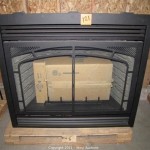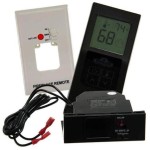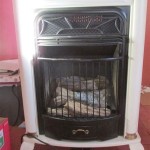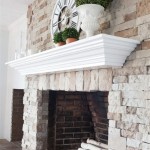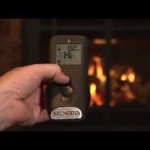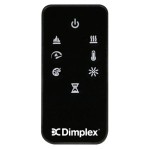Gas Fireplace Inserts With Blower: Efficiency and Ambiance
Gas fireplace inserts offer a convenient and efficient way to upgrade an existing masonry or zero-clearance fireplace. They provide the ambiance of a traditional fire without the hassle of wood-burning, offering ease of use and cleaner operation. A gas fireplace insert transforms an often inefficient wood-burning fireplace into a reliable supplemental heating source. When equipped with a blower, the efficiency and heating distribution capabilities of these inserts are significantly enhanced.
A gas fireplace insert is a self-contained unit that slides into the opening of an existing fireplace. These units are typically fueled by natural gas or propane and vent directly through the existing chimney using a liner system. This conversion allows homeowners to enjoy the aesthetic appeal of a fireplace with improved heating performance and reduced maintenance. A key component that impacts the performance of a gas fireplace insert is the integrated blower system.
How a Blower Enhances Heating Performance
The primary function of a blower in a gas fireplace insert is to circulate heated air more effectively throughout the room. Without a blower, much of the heat generated by the insert rises and dissipates near the ceiling or is lost up the chimney. A blower draws cooler air from the room, passes it over the heated firebox, and then forces the warmed air back into the living space. This forced-air circulation creates a more even temperature distribution, eliminating cold spots and maximizing the heating efficiency of the insert.
The blower is typically located behind or beneath the firebox of the insert. It is powered by electricity, often requiring a standard 120V outlet nearby. The blower's speed is often adjustable, allowing users to control the amount of air circulated and thus the level of heat output. Some models even feature automatic blowers that adjust their speed based on the firebox temperature, ensuring optimal performance and preventing overheating.
The increased circulation provided by the blower allows the gas fireplace insert to heat a larger area more effectively than it could without one. This can translate into lower heating bills as the insert supplements or even replaces the need for central heating in specific zones within the home. The blower essentially acts as a heat amplifier, taking the heat generated by the gas flame and distributing it throughout the room rather than allowing it to escape inefficiently.
Key Considerations When Choosing a Gas Fireplace Insert With Blower
When selecting a gas fireplace insert with a blower, several factors should be carefully considered to ensure optimal performance and satisfaction. The size of the space to be heated is a crucial determinant. Inserts are rated by their BTU (British Thermal Unit) output, which indicates the amount of heat they can generate. It's essential to choose an insert with a BTU rating appropriate for the square footage of the room. Selecting an insert that is too small will result in inadequate heating, while one that is too large can lead to discomfort and wasted energy.
The efficiency rating of the insert is another vital consideration. This rating indicates the percentage of fuel that is converted into usable heat. Higher efficiency ratings translate into lower fuel consumption and reduced operating costs. Look for inserts with high AFUE (Annual Fuel Utilization Efficiency) ratings to maximize energy savings. The blower itself should also be energy-efficient, minimizing its electricity consumption while providing adequate airflow. Some blowers operate more quietly than others, a factor that can be important for homeowners sensitive to noise. Consider models with adjustable speed settings to fine-tune the airflow and achieve a comfortable balance between heat output and noise level.
Installation is paramount to the safe and effective operation of a gas fireplace insert. It is strongly recommended to have the insert installed by a qualified and certified professional. Proper installation includes ensuring the correct venting system is in place, connecting the gas line safely, and verifying that the blower is wired correctly. A professional installer can also assess the existing fireplace structure to ensure it is suitable for the insert and make any necessary modifications. Neglecting proper installation can lead to safety hazards, such as gas leaks or carbon monoxide poisoning, as well as reduced heating performance.
Maintenance and Longevity
Regular maintenance is crucial to ensure the longevity and optimal performance of a gas fireplace insert with a blower. The frequency of maintenance depends on the usage and the specific model, but some general guidelines apply. The glass door of the insert should be cleaned periodically to remove soot and ensure a clear view of the flames. Use a cleaner specifically designed for fireplace glass, as harsh chemicals can damage the surface.
The blower should be inspected and cleaned regularly to remove dust and debris that can accumulate over time. Dust buildup can reduce the blower's efficiency and potentially cause it to overheat. Use a vacuum cleaner with a brush attachment to gently remove dust from the blower motor and fan blades. It is also advisable to inspect the venting system annually to ensure it is free of obstructions and in good condition. A qualified technician can perform a more thorough inspection and cleaning of the venting system, as well as check the gas connections for leaks.
The pilot light should be checked periodically to ensure it is burning properly. A weak or flickering pilot light can indicate a problem with the gas supply or the pilot assembly. Consult the owner's manual or contact a qualified technician for assistance with adjusting or repairing the pilot light. By following these maintenance guidelines, homeowners can ensure that their gas fireplace insert with a blower continues to provide efficient and reliable heating for many years.

35 Ruby Contemporary Intellifire Touch Direct Vent Fireplace Insert Blower And Remote Electronic Ignition Majestic

35 Ruby Traditional Intellifire Touch Direct Vent Fireplace Insert Blower And Remote Electronic Ignition Majestic

25 Ruby Traditional Intellifire Touch Direct Vent Fireplace Insert Blower And Remote Electronic Ignition Majestic

Belmont Small Gas Insert

Monessen Direct Vent Gas Fireplace Insert Reveal

Breckwell Large Direct Vent Fireplace Insert Bh2818i Hvacdirect Com

How To Buy A Gas Fireplace Insert Buyer S Guide From Regency

Enviro E Series Gas Or Propane Insert Fireplace Fireplaces By Cameron

Gdig3n Napoleon Fireplaces Oakville 3 Glass Gas Fireplace Insert Big George S Home Appliance Mart

Chaska 34l Gas Fireplace Insert With Blower Log Glass Rock

